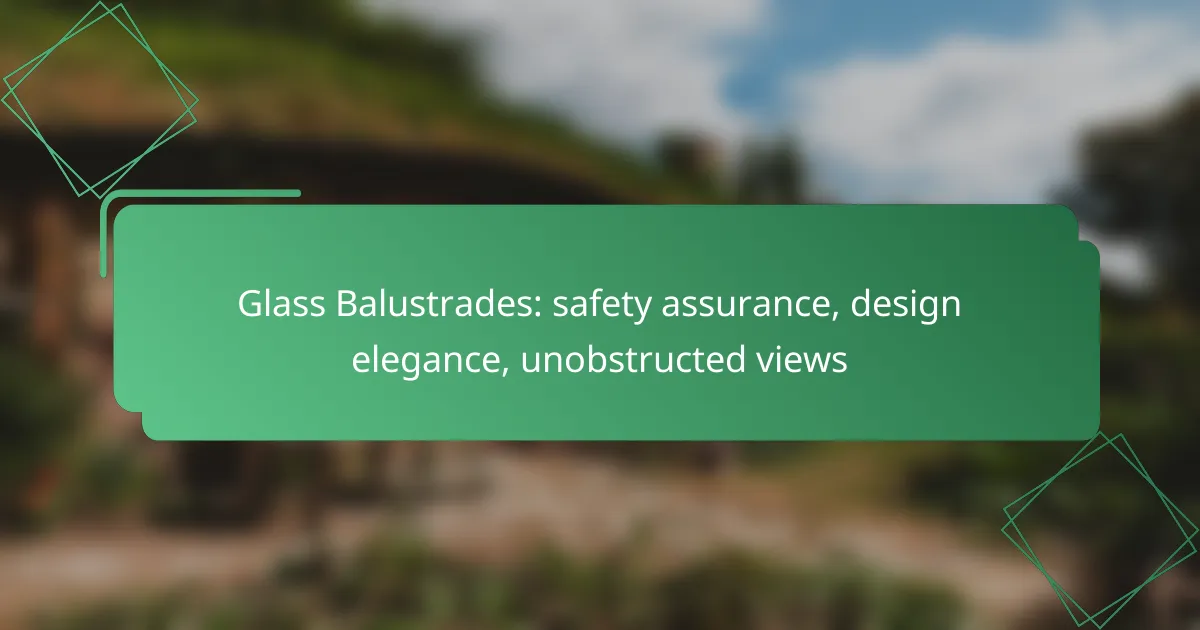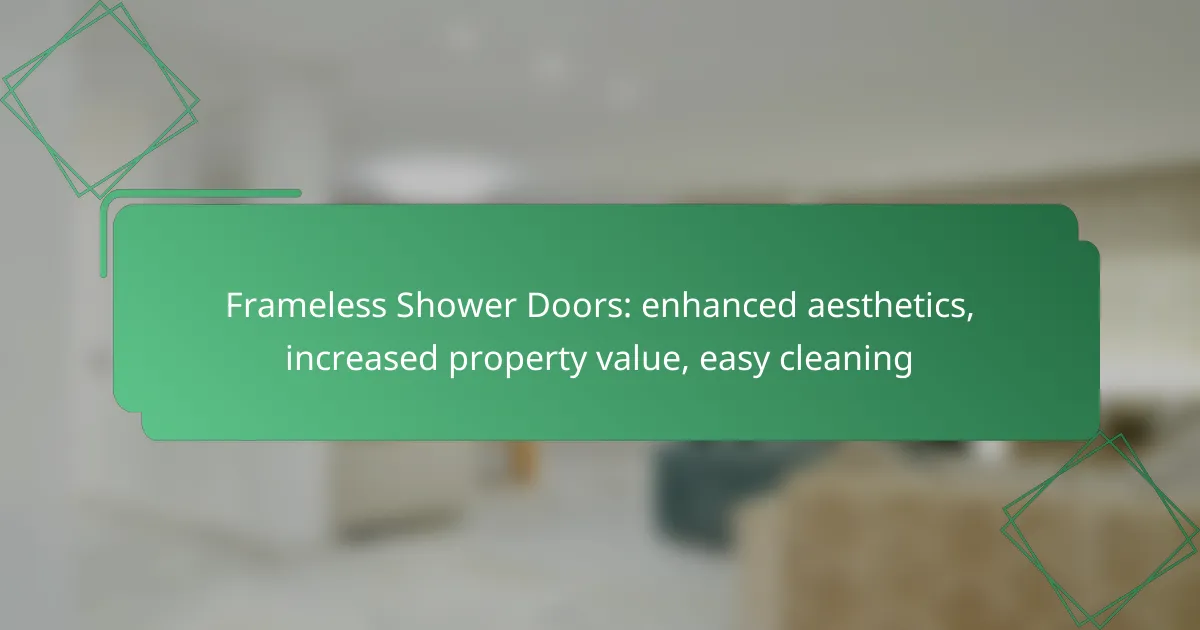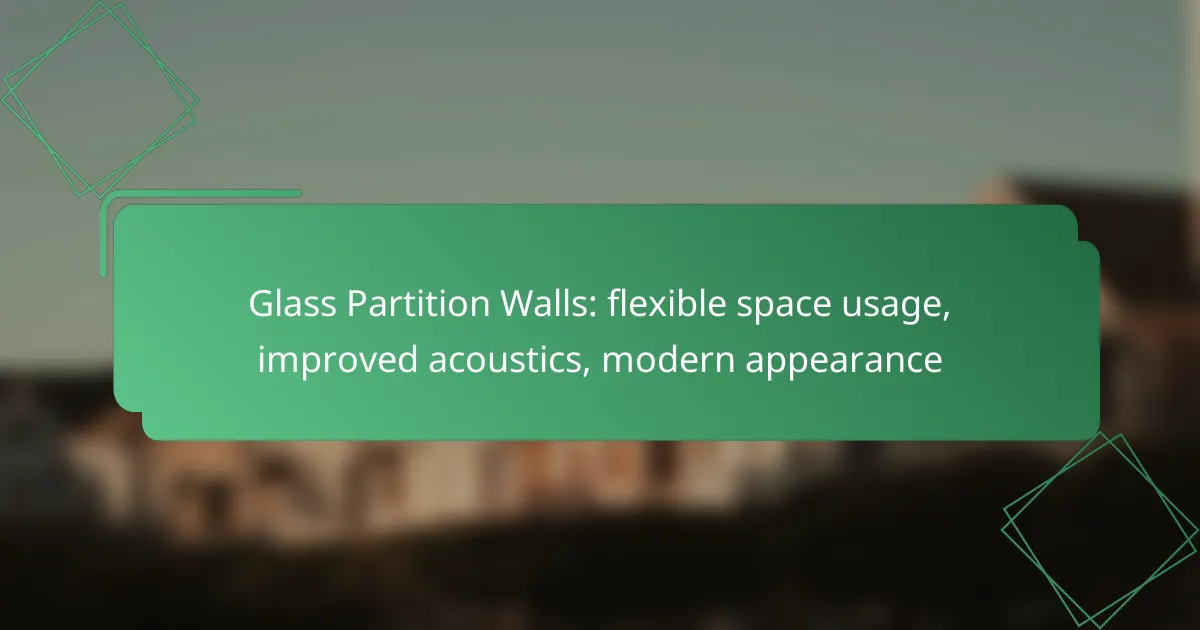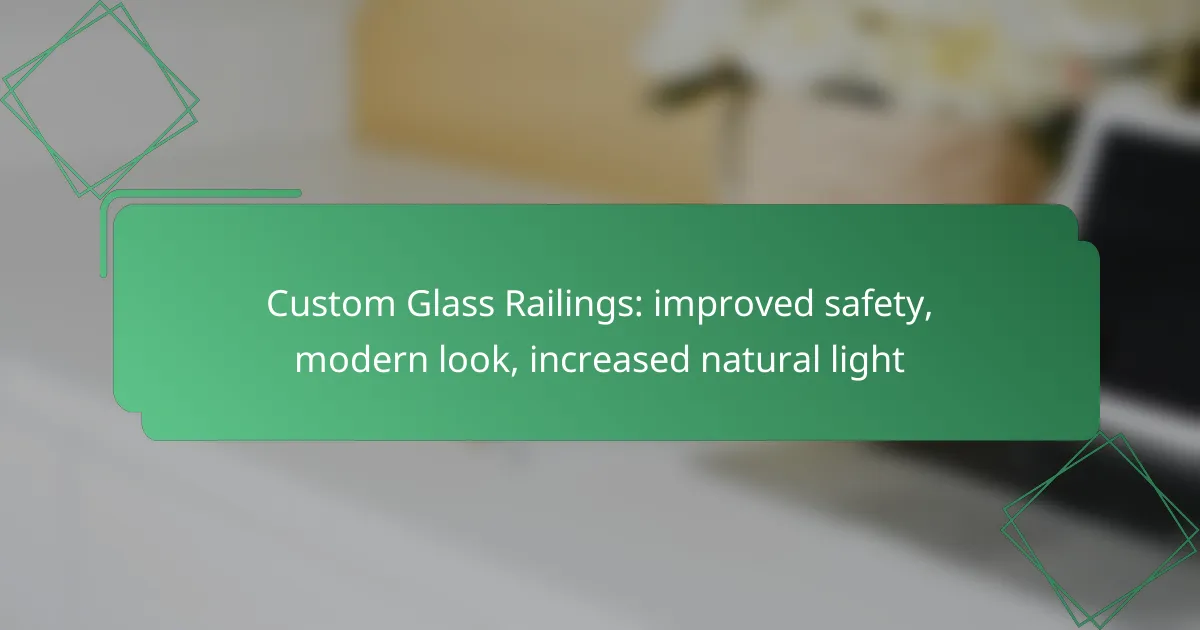Glass balustrades are an ideal choice for those seeking a blend of safety, elegance, and unobstructed views in their spaces. With their robust construction and adherence to safety standards, they provide a secure barrier while enhancing the overall aesthetic of both residential and commercial properties. Available in various designs, including frameless and framed options, glass balustrades can be tailored to suit diverse architectural styles and personal tastes.

What are the benefits of glass balustrades in Canada?
Glass balustrades offer numerous advantages in Canada, including enhanced safety, modern design, and unobstructed views. They are becoming increasingly popular for both residential and commercial properties due to their aesthetic appeal and practical benefits.
Enhanced safety features
Glass balustrades are designed to meet strict safety standards, providing a secure barrier while maintaining visibility. They are typically made from toughened or laminated glass, which is significantly stronger than regular glass, reducing the risk of breakage.
When installed correctly, glass balustrades can prevent falls and accidents, making them a safe choice for balconies, staircases, and pool areas. Regular inspections and maintenance ensure that they remain in top condition, further enhancing safety.
Modern aesthetic appeal
The sleek and contemporary look of glass balustrades complements various architectural styles, making them a versatile choice for any property. Their transparency allows for seamless integration with surroundings, enhancing the overall visual appeal.
Available in various designs and finishes, glass balustrades can be customized to fit personal tastes and preferences. This modern aesthetic not only elevates the look of a space but also creates a sense of openness.
Unobstructed views
One of the primary benefits of glass balustrades is their ability to provide unobstructed views. Unlike traditional materials, glass does not block sightlines, allowing occupants to enjoy their surroundings fully.
This feature is particularly valuable for properties with scenic landscapes or waterfront views, as it maximizes the visual experience without compromising safety. Homeowners can appreciate natural beauty while maintaining a secure environment.
Durability and low maintenance
Glass balustrades are highly durable and resistant to weather conditions, making them suitable for various climates across Canada. They do not rust or corrode, which is a common issue with metal balustrades.
Maintenance is minimal; regular cleaning with non-abrasive solutions is typically sufficient to keep them looking pristine. This low upkeep requirement makes glass balustrades a practical choice for busy homeowners.
Increased property value
Installing glass balustrades can enhance the overall value of a property. Their modern look and safety features appeal to potential buyers, making homes more attractive in the real estate market.
Properties with well-designed glass balustrades often stand out, leading to quicker sales and potentially higher offers. Investing in quality glass balustrades can yield significant returns when it comes time to sell.

How do glass balustrades ensure safety?
Glass balustrades ensure safety by utilizing strong materials, adhering to building codes, and employing secure installation techniques. These features work together to provide a protective barrier while maintaining aesthetic appeal and unobstructed views.
Tempered glass strength
Tempered glass is significantly stronger than regular glass, making it a popular choice for balustrades. It undergoes a heating and cooling process that increases its resistance to impact and thermal stress. This type of glass can withstand forces that would typically shatter standard glass, providing enhanced safety.
In practical terms, tempered glass balustrades can handle impacts from accidental bumps or falls, making them suitable for both residential and commercial settings. When selecting tempered glass, ensure it meets relevant safety standards, such as those set by ASTM or EN, to guarantee its strength and durability.
Building code compliance
Compliance with building codes is essential for the safety of glass balustrades. These codes dictate the minimum requirements for height, load-bearing capacity, and materials used. Adhering to these regulations helps prevent accidents and ensures that the balustrade can withstand various environmental conditions.
For instance, in many regions, the minimum height for a balustrade is often around 1 meter (approximately 39 inches) to prevent falls. Always check local building codes before installation to ensure your glass balustrade meets safety requirements and avoids potential legal issues.
Secure installation methods
Proper installation methods are crucial for the effectiveness of glass balustrades. Using high-quality fittings and ensuring that the glass is securely anchored can prevent failures. Common installation techniques include using stainless steel clamps or channels to hold the glass in place, which provide both stability and a sleek appearance.
Additionally, it is advisable to hire experienced professionals for installation to avoid common pitfalls, such as inadequate sealing or improper alignment. Regular maintenance checks can also help identify any issues early, ensuring the balustrade remains safe and functional over time.
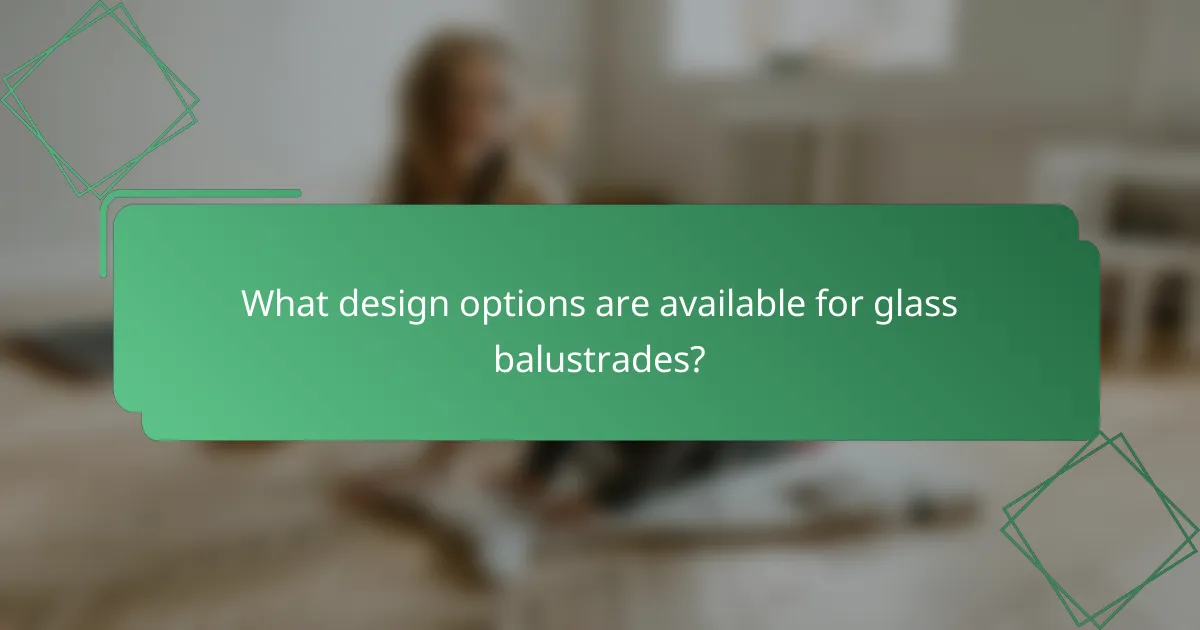
What design options are available for glass balustrades?
Glass balustrades offer a variety of design options that enhance safety while providing aesthetic appeal. Key choices include frameless designs, framed glass options, and customizable finishes, each catering to different architectural styles and personal preferences.
Frameless designs
Frameless glass balustrades create a sleek, modern look by using thick tempered glass panels secured with minimal hardware. This design maximizes visibility and light, making it ideal for areas where unobstructed views are a priority, such as balconies or staircases.
When considering frameless options, ensure the glass thickness is adequate, typically around 10 to 12 mm, to meet safety standards. Additionally, check local building codes for specific requirements regarding height and installation methods.
Framed glass options
Framed glass balustrades incorporate metal or wooden frames that provide additional structural support. This design can be more versatile in terms of style, allowing for various finishes and colors that can complement existing architecture.
While framed options may slightly obstruct views compared to frameless designs, they often offer enhanced durability and can be easier to install. Consider the frame material—aluminum, stainless steel, or wood—based on your climate and maintenance preferences.
Customizable finishes
Customizable finishes for glass balustrades allow homeowners to personalize their installations to match their decor. Options include tinted glass, frosted finishes, or decorative patterns that can enhance privacy while maintaining a stylish appearance.
When selecting finishes, consider the overall aesthetic of your space and how the glass will interact with natural light. Additionally, ensure that any finishes comply with local regulations regarding safety and visibility, particularly in public or high-traffic areas.
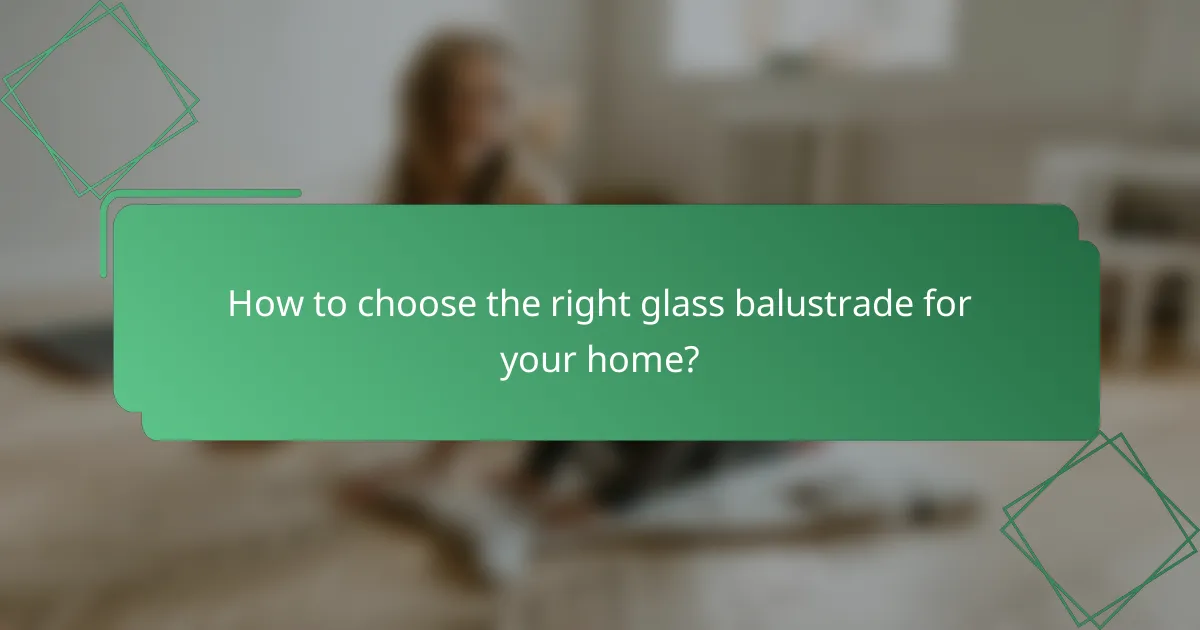
How to choose the right glass balustrade for your home?
Choosing the right glass balustrade involves considering safety, design, and local regulations. Prioritize your needs by assessing compliance with safety standards, ensuring aesthetic compatibility with your home, and evaluating your budget.
Assessing local regulations
Before installing a glass balustrade, check your local building codes and regulations. These rules often dictate the height, thickness, and type of glass required for safety purposes.
In many regions, balustrades must meet specific safety standards to prevent falls, especially in elevated areas. Consult with local authorities or a professional to ensure compliance and avoid costly modifications later.
Evaluating design compatibility
Your glass balustrade should complement the overall design of your home. Consider the architectural style, color schemes, and materials used in your existing decor.
For a modern look, frameless glass balustrades offer a sleek appearance, while those with metal frames can add a touch of elegance to traditional homes. Visualize how different designs will enhance your space before making a decision.
Budget considerations
Establishing a budget is crucial when selecting a glass balustrade. Costs can vary widely based on materials, design complexity, and installation requirements.
On average, you might expect to spend anywhere from a few hundred to several thousand dollars. Factor in additional costs for installation and potential maintenance to ensure your project stays within budget.
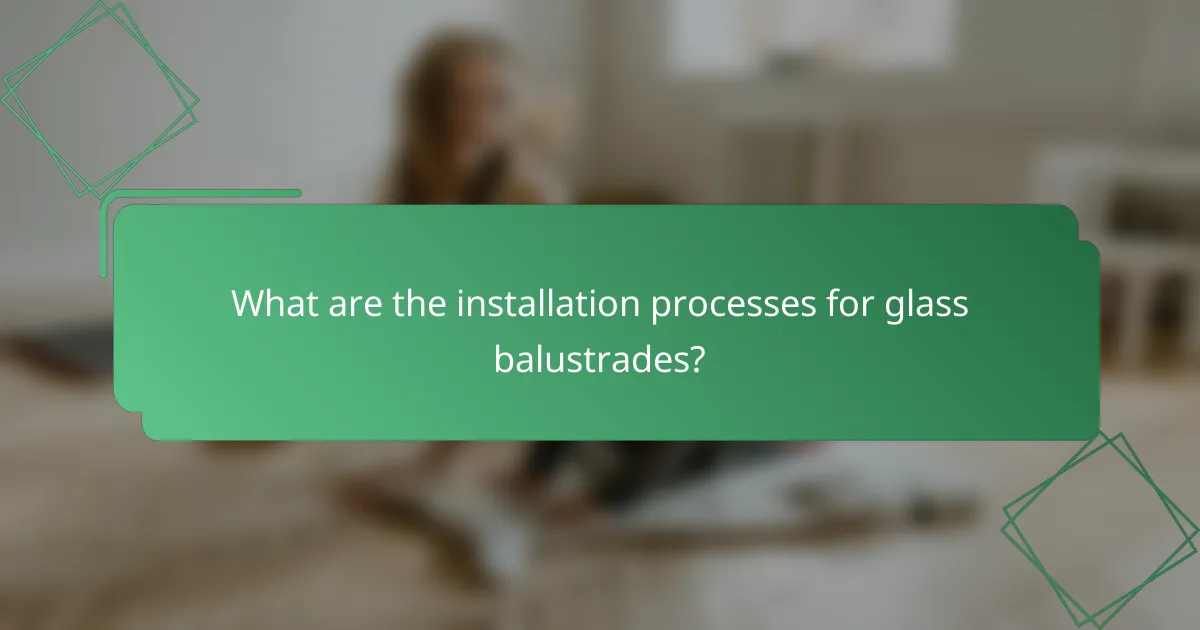
What are the installation processes for glass balustrades?
The installation processes for glass balustrades involve careful planning, professional or DIY execution, and adherence to safety standards. Proper installation ensures both aesthetic appeal and structural integrity, providing safety and elegance in various settings.
Preparation and planning steps
Before installation, assess the area where the glass balustrade will be placed. Measure the dimensions accurately to determine the amount of glass and hardware needed. Consider local building codes and regulations, as they may dictate specific requirements for height, thickness, and safety features.
Next, choose the type of glass and frame materials that suit your design preferences and budget. Options include tempered glass for safety and various finishes for the framing, such as stainless steel or aluminum. Create a detailed plan that outlines the installation steps and required tools.
Professional installation services
Hiring professional installation services can ensure that the glass balustrade is fitted correctly and safely. Professionals typically have the experience and tools necessary to handle the installation efficiently, minimizing the risk of errors that could compromise safety.
When selecting a service, check their credentials, reviews, and previous work to ensure quality. Discuss your design and safety requirements with them, and obtain a detailed quote that includes all materials and labor costs. This can range from a few hundred to several thousand dollars, depending on the project scale.
DIY installation tips
If you opt for DIY installation, start by gathering all necessary tools, including a level, drill, and safety gear. Follow the manufacturer’s instructions closely, as they provide specific guidance on handling and securing glass panels. Ensure that you have a helper, as glass can be heavy and unwieldy.
Common pitfalls include improper measurements and inadequate support for the glass panels. Double-check all dimensions before cutting or ordering materials. It’s also crucial to ensure that the balustrade is securely anchored to prevent accidents. Consider using a temporary support system while securing the glass to maintain stability during the installation process.
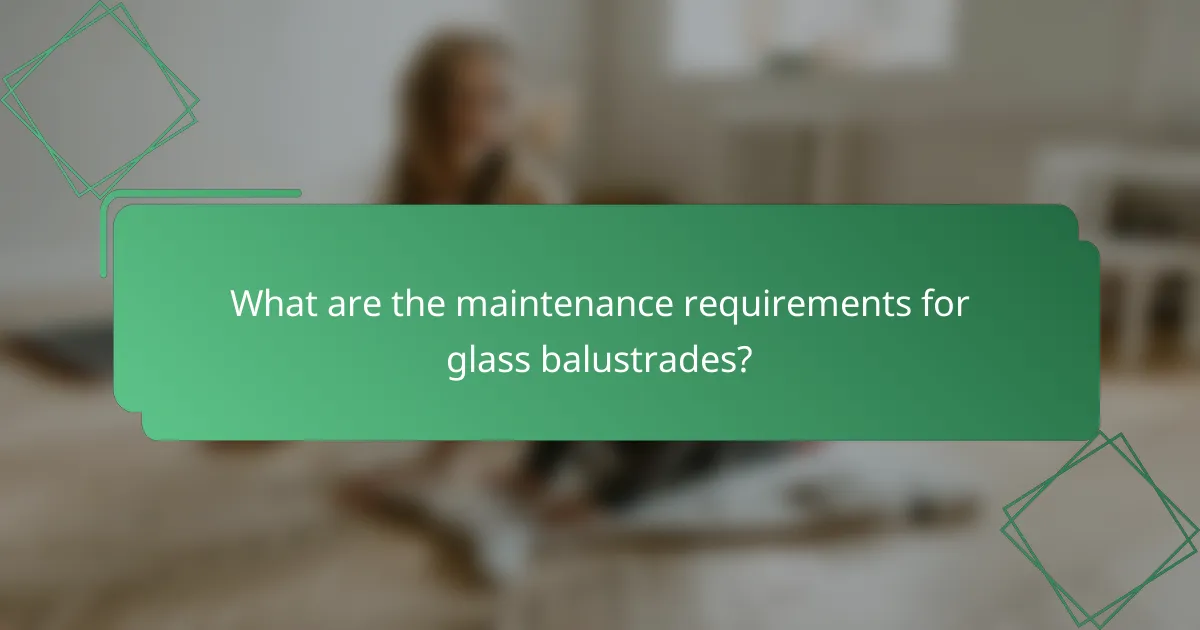
What are the maintenance requirements for glass balustrades?
Glass balustrades require regular maintenance to ensure safety and aesthetics. This typically includes cleaning, inspection for damage, and checking fittings to maintain structural integrity.
Cleaning glass balustrades
To keep glass balustrades looking pristine, regular cleaning is essential. Use a soft cloth or sponge with a mild detergent solution to avoid scratches. For best results, clean them every few weeks, especially in areas with high dust or pollution levels.
Inspecting for damage
Regular inspections are crucial for identifying any cracks or chips in the glass. Check the balustrades at least once a month, looking for signs of wear or stress. If any damage is found, it’s important to address it immediately to prevent safety hazards.
Checking fittings and hardware
Ensure that all fittings and hardware are secure and free from corrosion. Inspect the brackets and clamps regularly, as loose or rusted components can compromise the safety of the balustrade. Tighten any loose screws and replace corroded parts as needed.






